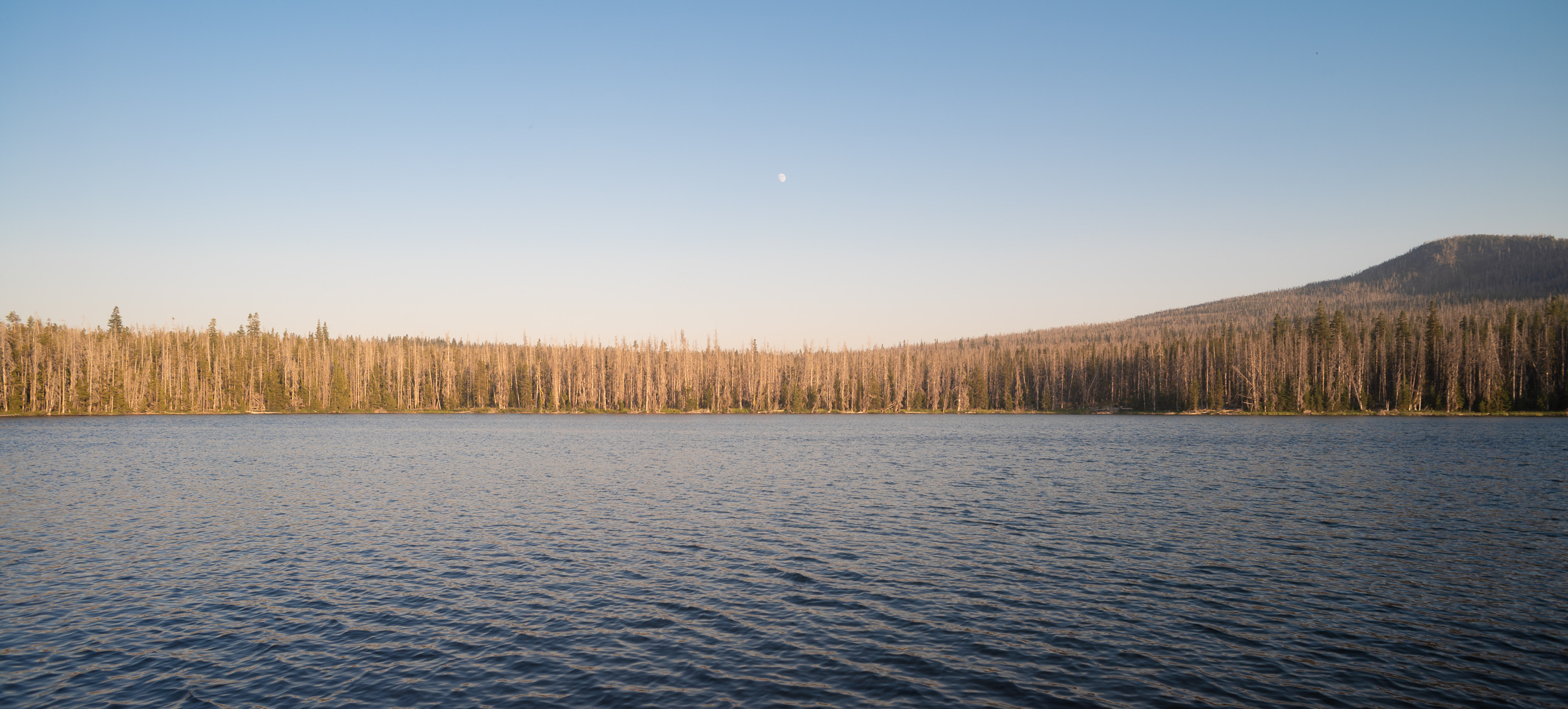
by DGR News Service | Aug 24, 2020 | Biodiversity & Habitat Destruction
Large and old-growth trees in the dry eastern region of the U.S. state of Oregon are under threat as the agency which regulates Forest Service lands plans to remove existing protections, George Wuerthner reports.
By George Wuerthner / The Wildlife News / August 13, 2020
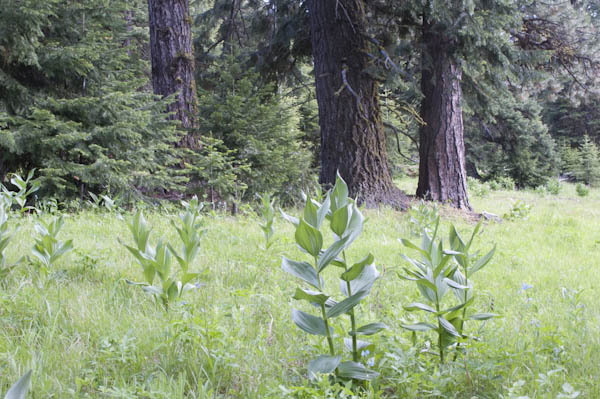
Old-growth grand fir on the Ochoco National Forest could be logged if the proposed removal of the 21-inch rule is adopted. Photo by George Wuerthner
The Forest Service has begun a 30 day comment period on its proposal to eliminate the 21-inch rule or what is known as the Eastside screens. The plan would remove a prohibition against cutting trees larger than 21 inches in the drier forests east of the Cascades in Oregon and Washington. The agency suggests that forests are denser than historical conditions and have shifted in their species composition. Not all researchers agree with this interpretation, but since these scientific studies don’t support more logging, they are usually ignored.
The agency researchers conclude that thinning forests is necessary to promote “forest health” and cutting of larger trees will hasten this transition. Since big trees enhance the profitability of timber sales, there is intense pressure from the timber industry for cutting big trees. However, the elimination of the 21- inch rule will increase the removal of large trees critical to healthy forest ecosystems.
The 21-inch rule was implemented in 1994 to protect larger trees from logging, partially in response to the realization that big trees have a disproportional ecological influence. Unlike the ancient forests west of the Cascades inhabited by the spotted owls, which gained some protection from the Endangered Species Act, eastside forests were vulnerable to the removal of old-growth forests.
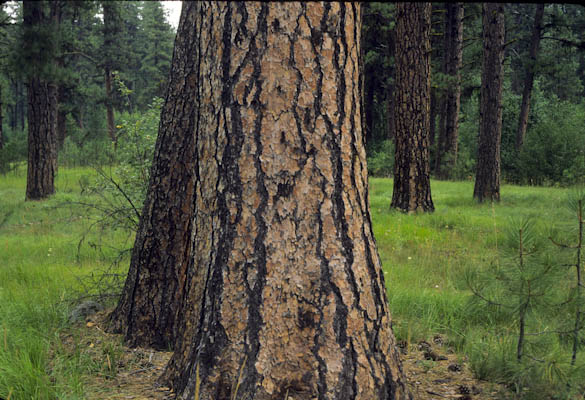
Large trees, even if dead, provide important ecological functions such as carbon storage and wildlife habitat. Photo by George Wuerthner
In response to the loss of large trees created by excessive logging, Congress convened a scientific panel to review the issue. However, unlike many such scientific panels that rely exclusively on forestry schools and/or the Forest Service for advice, Congress asked the Wildlife Society, the American Fisheries Society, the Society for Conservation Biology, and the American Ornithologists’ Union to produce the Eastside Forests Scientific Society Panel report. The panel came out with 13 suggestions, including a prohibition on cutting larger trees older than 150. The Forest Service adopted this policy recommendation.
But times have changed.
With the advent of the Trump Administration, there is intense pressure to increase the cut of timber. This pressure, along with collaborators who are more than willing to accommodate the timber industry’s and Forest Service demands (and rely exclusively on their science), many members of collaboratives including some so-called environmental groups support more logging.
In yet another example of the tail wagging the dog, the Forest Service now suggests that to “restore” eastside forests, and “save” them from (god forbid) death from wildfire or beetles, the agency must log the forest.
Part of the underlying assumption behind restoration is that forests are denser now than in the historical past due to fire suppression. The idea that you can restore the forest to some “historic” condition ignores the fact that all vegetation is a reflection of climate. The reason we see more mortality from fires, beetles, drought, and other ecological processes is primarily to changing climate. It’s warmer and drier. With less precipitation, higher temperatures, and more drought, you have the perfect ingredients for wildfire and bark beetle mortality.
There are many things wrong with this perspective.
Trying to emulate the historic forest condition created by the climate at that point in time, is not relevant to the forest structure today.

Part of the assumption behind removal of 21-inch screens is that eastside forests were characterized by open stands dominated by ponderosa pine as seen here. However, some researchers challenge the assumption that such forest structure was as common as presumed. Photo by George Wuerthner
Furthermore, natural evolutionary processes like bark beetles, drought, and fire are better, selecting which trees should and will survive than a logger with a chainsaw. For instance, it has been demonstrated that some trees have greater resilience to bark beetle predation, but this genetic advantage is not readily visible to foresters. By randomly logging/thinning the forest, logging may reduce the number of trees with genetic resistance to natural stresses, degrading the “resiliency” of the forest.
In a sense, the Forest Service and its collaborative allies see natural ecological processes like fire and beetles as the “enemy”. Somewhat like the attitude of some hunters view predators like wolves and cougars as “damaging” the deer and elk herds, many foresters and agency personnel view natural mortality from fires and beetles as counter to forestry goals of “green trees” and a source of fodder for sawmills.

Western larch, Glacier Mountain, Strawberry Mountains, Malheur National Forest, Oregon
This industrial forestry perspective is widely held in the timber industry, Forest Service, and its collaborative allies.
Yet dead trees are essential to healthy forest ecosystems.
They store carbon. They provide habitat as snags and down wood to many species from salamanders to animals as large as bears. For instance, grizzly bears rely on ants found in down trees for a significant proportion of their summer diet. And down trees in streams enhance the productivity of aquatic ecosystems. A substantial portion of birds and other wildlife utilize snags and dead trees at some point in their lifecycles. This is why some researchers have reported high biodiversity in the snag forests that result after a wildfire or bark beetle attacks.
Another rationale for eliminating the 21-inch rule is to reduce competition for resources and increase the remaining trees’ growth. Fast-growing trees are a goal of the Industrial Forestry Paradigm, but it is not necessarily good for healthy forest ecosystems. Slow-growing trees have denser wood, which makes the snags and down wood that remains after they die more resistant to rotting. Therefore, such dense wood is retained longer in the environment providing the above wildlife habitat and carbon storage benefits.
Although it is seldom admitted, one of the chief reasons for removing the 21-inch rule is to increase the economic viability of logging projects.
This is revealed in a recent review of the 21 inch rule in a paper recently published by the Forest Service. In that review, the authors suggest, ” Including larger trees in restoration prescriptions can increase the acreages where fuel treatments are financially feasible. Prestemon et al. (2012) showed that allowing the harvest of live trees over 21 inches increased the acreage in the West where fuel treatments were economically viable, even without considering avoided damage values”.
The paper goes on to note that: “Throughout the West, including live trees over 21 inches in fuel treatment harvests increased the viable treatment area by 2.6 times.” The review also notes: “It is important for managers and stakeholders to consider how large harvested trees can be processed locally to support local mills and be consistent with collaborative group goals.”
Here we see that meeting the goals of the collaboratives is more important than preserving healthy forest ecosystems.
The review admits that: “if no timber products could be sold from forest restoration actions, there was no place on the east side where the expected net economic benefit from fuel treatment would be positive, even when accounting for avoided wildfire damage.” As a consequence, we get to the heart of the issue. Without logging big trees, most thinning and other projects on eastside forests make no economic sense.
One way logging is further justified is by stewardship contracts. Stewardship contracts permit the Forest Service to take profits from timber sales and utilize for other forest projects like mitigating the ecological damage from previous logging projects by removal of culverts or closure of roads. I have often heard the so-called environmental representatives on collaboratives justify logging to me by saying, “ ?”
Of course, I support closing roads, but we don’t need to build more roads and log the forest to get some money to fix the damage from previous logging projects. Given the amount of money, the FS typically loses on timber sales. Putting agency funds towards road closure and other real restoration could be accomplished without having to log the forest to pay for these projects.
If you wish to send in your comments on the proposal to eliminate the 21-inch rule, individuals and entities are encouraged to submit comments via webform at https://cara.ecosystem-management.org/Public/CommentInput?project=58050.
Comments may also be sent via e-mail to: M.FS.EScreens21@usda.gov.
You can find the full & original article here: http://www.thewildlifenews.com/2020/08/13/eastside-forest-scam-the-removal-of-the-21-inch-rule/. Featured image by Max Wilbert.

by DGR News Service | May 1, 2020 | Strategy & Analysis, The Solution: Resistance
What would a revolutionary permaculture movement look like? As food shortages begin to sweep the world, the prospect of a Deep Green Resistance—a movement combining relocalization with organized political resistance—grows ever more relevant.
Can Permaculture Become a Revolutionary Force?
By Max Wilbert
As coronavirus unravels global supply chains, wildfires cool in Australia, Arctic ice continues to decline, and 2019 goes down as the 2nd hottest year on record, we all know how bad things are.
Unless there is fundamental change to the socio-economic fabric of global societies, the future is bleak.
Here in the United States, both major political parties are completely insane. Even the most progressive Democratic politicians are only proposing what amount to relatively minor reforms to the economic systems we live under.
Policy proposals like The Green New Deal in the U.S. and plans like the Energiewende in Germany aim to maintain a modern, high-energy consumption lifestyle while only changing the sources of energy we use. Much more is needed.
As we accelerate further into global crisis, we are seeing increased instability around the world. Refugees are on the march, food instability is rising, extreme weather events are becoming commonplace, and as a result authoritarianism is on the rise. Trump, Putin, Bolsonaro, and Erdogan reflect the hopes of a fearful population looking for a strong patriarch figure to lead them to safety.
But there is no safety to be had behind walls and armies, not when the world is burning.
Industrial Civilization is Fragile
A founding principle of Deep Green Resistance is the understanding that modern industrial civilization is fragile. While globalized supply chains enable the system to easily recover from regional shocks, industrial capitalism is highly vulnerable to global disruptions, as CoViD-19 has shown.
More of these shocks are coming, as industrial civilization undermines the ecological foundations of life. Soil depletion and desertification, aquifer depletion and fresh water pollution, deforestation, ocean acidification, the rise of dead zones, and overfishing are just a few of the trends.
We are seeing cracks in the industrial food system, which is leading people to question modernity. This questioning is a good thing. It’s essential that we begin a wholesale shift away from high-energy, consumeristic lifestyles and towards local, small-scale, low-energy ways of life. We need to abandon industrial capitalism before it destroys all life on the planet.
Various movements such as Transition Towns and permaculture have been saying this for a long time. Their message is essential, but in my opinion incomplete. The dominant culture has always destroyed and exploited low-energy, small scale, sustainable human communities.
That’s what colonization is. And it’s still going on today. A failure to grapple with the racist violence necessary to maintain and expand modern civilization is one reason why permaculture movements have remained mostly white and middle-class (capitalism, and poor people’s resulting lack of access to land and free time, are another critical factor in this).
Building a Revolutionary Permaculture Movement
Therefore, not only do we need to relocalize, we also need community defense and resistance movements dedicated to pro-actively dismantling industrial civilization in solidarity with colonized peoples and indigenous communities. We can’t just walk away. We have to fight like hell and bring a revolutionary edge to all of our organizing. We have to combine building the new with burning the old. The faster the system comes to a halt, the more life will remain. And there is no time to waste. This is probably the only way to save the planet and guarantee a livable future.
The failure of mainstream political parties of technological solutions are becoming increasingly clear to average people. They are looking for solutions. Popular movements are becoming increasingly confrontational. But still, it is very rare that anyone is able to articulate a feasible alternative to the dominant culture, the techno-industrial economic system.
A politicized permaculture movement has this alternative. A political permaculture movement, allied with resistance movements and working to rapidly re-localize and de-industrialize human populations could provide a feasible alternative to partisan gridlock while demonstrating a tangible real-world alternative. This movement needs to begin at the local and regional levels, seizing power in schools, county offices, water and soil boards, and building our own power structures through localized food networks, housing, labor, and political organizing.
I have heard it said that permaculture is a revolution disguised as gardening. Perhaps it is time to drop the disguise.
Our Pilot Project
In Oregon, Deep Green Resistance is engaged in a community mutual aid project in collaboration with local indigenous organizers and other allies. We are distributing to the community free of charge:
- Food
- Seeds and gardening supplies
- Plant starts
- Gardening pamphlets and guides
- Freshly-hatched ducklings and information as to their care
- Seedlings of native oak trees

We have chosen to distribute native oak seedlings because native oak savanna is the most endangered habitat in the country. More than 95% of it has been destroyed since colonization. Second, because acorns can be a valuable staple food. Third, because planting native oak trees (and assisting in the northward migration of valuable non-native food trees) can help begin the transition to perennial food systems while both mitigating and preparing for global warming and biodiversity collapses (oaks are prized by wildlife and oak savanna is an extremely biodiverse habitat).
At the same time, we are also distributing political literature and engaging in (socially-distanced) conversations with our community members about these issues. Our goal is to strengthen and build local food systems, and also resistance networks with radical analysis of the political situation.
Oregon is perhaps ahead of the curve. It’s a mostly rural state with a relatively small population. It has long been a hub for local food production, permaculture, and relocalization. These projects will be harder to implement in urban communities, and poverty compounds all the challenges. However, the skills to live sustainably already exist. The barriers are time, funding, political education, and most importantly the will of the people. As the famous saying goes, only ourselves can free our minds. Free your mind and begin to build this new revolutionary transformation.
We hope to see this project replicated around the world. We take inspiration from the many people already engaged in this sort of work, especially those who combine ecological awareness, practical relocalization, and revolutionary resistance. Contact us for more information, to get involved, or to have a conversation about implementing similar projects in your community.
Max Wilbert is a third-generation political dissident, writer, and wilderness guide. He has been involved in grassroots organizing for nearly 20 years. His essays have been published in Earth Island Journal, Counterpunch, DGR News Service, and elsewhere, and have been translated into Spanish, Italian, German, and French. His second book, Bright Green Lies, is scheduled for release in 2021.

by DGR News Service | Aug 9, 2019 | Biodiversity & Habitat Destruction
By Max Wilbert / Images: public domain
Here is a familiar fact to many people across the United States and the world: the Redwoods of Northern California are the tallest trees in the world at nearly 400 feet.
This is both true and false. It’s true because right now the redwoods are the tallest trees. But it’s false because not long ago, that wasn’t the case.
The tallest known redwood is 379 feet tall. But historical accounts are full of references to Douglas Fir trees 400 feet tall and more. One tree in the lower North Fork of the Nooksack River Valley is thought to have been 465 feet tall, probably the largest known tree ever recorded anywhere on the planet. And it wasn’t alone.
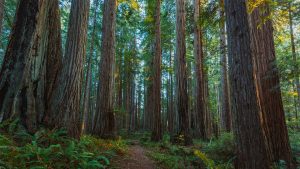 Micah Ewers of Portland writes, “If this was just a freak occurrence, I would write it off. But I’ve collected 90 to 100 reports of 300- to 400-foot Douglas firs. A hundred years ago, trees rivaling the height of the redwoods were fairly common. The whole Puget Sound was just filled with giant trees.”
Micah Ewers of Portland writes, “If this was just a freak occurrence, I would write it off. But I’ve collected 90 to 100 reports of 300- to 400-foot Douglas firs. A hundred years ago, trees rivaling the height of the redwoods were fairly common. The whole Puget Sound was just filled with giant trees.”
His research found references to many trees that would be considered world record holders today on the sites of current downtown Seattle and downtown Vancouver in British Columbia.
So if you find yourself among the skyscrapers of Seattle or Vancouver, or wandering through the neighborhoods and suburbs or young woodlands of the territory in between, take some time to reflect that where you are walking was not that long ago full of the largest trees on the planet, trees who were killed for profit, for greed, for colonization, for capitalism, for growth, for progress.
Followup:
Micah Ewers responded to this post with an extensive comment below. We’re copying the text here. Thanks Micah!
Thanks for the mention. Yeah the size of forest that was growing in Seattle was astounding. 250 – 300 foot trees were common back then. I am trying to follow up on an old report of a 412 footer said to have been logged around Tacoma, and another big tree 17.8 feet in diameter east of Seattle was reported in 1909 at over 400 feet, the tree was so big that the Puget Sound railroad had to be built around it. Another fir tree reported in Chehalis County in 1893 was measured with survey instruments at over 400 feet, and 17 feet diameter. There were even reports of 300 foot cedars, and 400 ft Sitka Spruce, 20 ft in diameter in Washington and Oregon 100 years ago.
If you look up “Ravenna Park” in a google image search you can find old post cards which give the size of some of the trees that used to grow in Seattle’s most treasured city Park,… Before they were all cut down for quick cash between the 1910’s – 1920’s… the excuse was that the trees were dying and needed to come down, which may have been true for one, but not the whole stand. Those fantastic trees were listed on the post cards as from 270 to about 400 feet in height and 10 to 12, even 14 feet in diameter. Age estimates were between 1,000 and 2,000 years for the oldest of them. Just imagine these massive old beasts jutting out of the little creek and valley near the University district.
Same story in Vancouver, only at least Stanley Park was preserved and wind had blown down the last of the 325 footers in the park in 1926. Portland Also had some 300 – 330 footers in its vicinity, the last of them logged in the 1910’s – 20’s.
I think the redwoods and Douglas fir were actually tied for tallest tree, only that the tallest reported Redwoods I have discovered were up to 424 foot circa. 1886, while the highest reports for Douglas fir is 465. I actually heard a story from a guy in a Gardenweb forum who claimed his father had felled a 480 foot fir in the Black Hills, near Bordeaux, Washington around 1930– although, this is second hand, so it remains an unsubstantiated claim, but the 2008 study on theoretical limits of Douglas fir height by Oregon State University came up with a range of 99 – 145 meters as the possible limits for Doug fir (325 – 475 ft), whereas a 2004 study on Coast Redwoods yielded a slightly smaller limit of 400 – 430 ft.. So it may well be that Douglas fir was the supreme master of stature after all! Redwood holds the title for now, although it wouldn’t surprise me if a few hidden giant Douglas fir, over 350 feet high, still exist hidden in some valley awaiting discovery.
The last real big fir that has survived into modernity (which has been publicly reported anyways) was the “Mt. Pilchuck giant”, fir tree cut down on October 22, 1952 near the small town of Verlot, Washington. The big tree, 700 years old, was reported to be over 350 foot high, 11 ft 6 inches diameter and 30,000 board feet. From that point on, records are few for the big trees over that height range, except of course, the redwoods in California which have about 300 trees alive today of that height. (Impressive, considering 96% of old growth Coast Redwood has been clear-cut).
Editor’s Note: this piece was originally published in 2015, and is being republished here with a few minor edits.

by DGR News Service | May 18, 2019 | Toxification
True change can only be driven by revolutionary action and long-term radical organizing — not chemical collusion and compromise.
Last year, I volunteered to plant native species at the Spencer Creek-Coyote Creek wetlands southwest of Eugene, Oregon. This site, owned by the McKenzie River Trust (MRT), is an important riparian area at the confluence of two streams and is habitat for a wide range of plants, mammals, amphibians, birds, and other forms of life.
After arriving at the site, we learned during the orientation that herbicides had been applied in the area we were to be working to remove undesired plants. This did not sit well with me. I contacted McKenzie River Trust several months later and met with their conservation director to discuss chemical use. He explained that organizations like MRT are tasked with conserving large areas of land and don’t have the volunteer resources or staff to conduct non-chemical restoration. I suggested that MRT engage the community in dialogue around these issues in order to attempt an alternative.
The McKenzie River Trust disclosed that it has used pesticides including Glyphosate (aquatic formulation), triclooyr 3A, clethodim, aminipyralid, clopyralid, and flumioxazin over the past two years. MRT also uses chemicals at the Green Island site at the confluence of the Willamette and McKenzie rivers. The organization even has job descriptions that include specific reference to “Chemical control of invasive species… apply herbicides” in the activities list. It maintains a certified herbicide expert on staff. A representative of McKenzie River Trust told me that the organization has changed its volunteer policy to prevent the sort of herbicide exposure volunteers had earlier this year at the Spencer-Coyote Wetlands — but this doesn’t address the ecological impacts, or impacts on local residents.
I sympathize with relatively small organizations like McKenzie River Trust. They are operating in a bind whereby they are forced to either concede important habitat to aggressive invasive species, use poison, or attempt to mobilize the community to maintain land by hand. As they write in a fact sheet, “When working on large acreages, [herbicides] are the most efficient and cost-effective tool at our disposal.”
However, there is no excuse for manufacturing these substances, let alone deliberately releasing them into the environment.
We all assume that restoration and conversation groups have the best interests of the natural world at heart. But many of these groups regularly use chemical pesticides for land management, including chemicals that have been shown to cause cancer, birth defects, hormonal issues, and other health problems in humans and other species. This includes not just small local groups like The McKenzie River Trust and The Center for Applied Ecology, which are based in my region of western Oregon, but also large NGOs like The Nature Conservancy (TNC).
I have spoken with representatives of each of these organizations, and have confirmed that they actively use chemical herbicides.
The Nature Conservancy, for instance, uses organophosphate herbicides (the class that includes Glyphosate, the active ingredient of the popular weed-killer RoundUp) and a range of other chemicals on non-native species in the Willow Creek Preserve in southwest Eugene as well as thousands of other locations globally. The organization notes on its website that “herbicide use to control invasive species is an important land management strategy.”
The intentional release of toxic chemicals into the environment is an ironic policy for environmental groups, given that the modern environmental movement was founded on opposition to the use of pesticides (a category which includes herbicides). The 1962 publication of Rachel Carson’s book Silent Spring is taken by many as the beginning of the modern environmental movement.
Pesticides are a persistent, serious threat to all forms of wildlife and to the integrity of ecology on this planet.
Amphibians, due to their permeable skin, are especially sensitive to the effects of pesticides. These creatures often spend their entire lives on the ground or underground, where pesticides may seep. Even at concentrations of 1/10th the recommended level, many pesticides cause harm or are fatal to amphibians.
Bees exposed to herbicides may be unable to fly, have trouble navigating, experience difficulty foraging and nest building. Exposure may lead to the death of bees and larva. One study showed that Glyphosate effects bees’ ability to think and retain memory “significantly.”
While herbicides are less toxic to birds and large mammals than other pesticides that are used to kill bugs and small animals like mice, several studies have shown interference with reproduction. Not all poisoning results in immediate death. Impacts might include reduced body mass, reproductive failure, smaller broods, weakening, or other effects.
Pesticides, in general, are implicated in dramatic collapses in bat populations, threaten invertebrates, and kill or harm fish. Additionally, they bioaccumulate in flesh — that is, their levels concentrate in the bodies of predators (including humans) and scavengers that eat poisoned rats or other animals that we deem as pests.
Pesticides are applied much more widely than most people realize. They are used along roads, in parks, in front of businesses, and along power lines. In forestry and agriculture, thousands of tons of chemicals are applied in Oregon every year. The Oregon Department of Transportation uses herbicides to spray roadsides across the state. A recent “off-label” use of a herbicide has caused the death of hundreds of Ponderosa pines along a 12-mile stretch near Sisters, OR. Across much of the United States, insecticides are sprayed widely in cities and water bodies to kill mosquitoes. And private organizations and individuals use pesticides widely as well. A southern California study that took place between 1993 and 2016 found a 500 percent increase in the number of people with glyphosate in their bloodstream during that period, and a 1208 percent increase in the average levels of glyphosate they had in their blood.
The effects of these chemicals on humans can be disastrous. Pesticides are linked to neurological, liver, lymphatic, endocrine, cardiovascular, respiratory, mental health, immune, and reproductive damage, as well as cancer risk. As far back as 1999, pesticide use was believed to kill 1 million humans per year. Yet these toxic chemicals continue to be used today.
***
According to permaculture expert Tao Orion, author of Beyond the War on Invasive Species, more volunteer work, or active harvesting, perhaps through collaboration with Indigenous groups, can eliminate the need for chemicals entirely. “If you’re considering that one or two people are going to manage 500 acres,” she said, “you’re setting yourself up for herbicide use. It’s a cop-out… Tending these areas may cause rare plants to increase. There is a lot of evidence now that this is indeed the case. But that goes against the [commonly accepted] American wilderness ideology.”
Orion says the use of toxic herbicide mixes is common as well. “I did an interview with the founder of the Center for Applied Ecology, and he said ‘we often just mix up RoundUp and 2, 4-D, that’s a surefire mix we’ve found,’” Orion said. As some may remember, 2, 4-D is one-half of the Agent Orange defoliant that was widely used in the ecocidal Vietnam War and has been linked to extremely serious human and non-human health issues.
In her book Beyond the War on Endangered Species, Orion details Agribusiness giant Monsanto and other pesticide industry corporations making a deliberate shift to market and sell chemicals to ecological restoration organizations. This is often done with the help of incomplete or poorly executed science claiming that pesticides are harmless. Jonathan Lundgren disagrees. This Presidential Early Career award winner for Science and Engineering was forced out of his USDA research scientist position after exposing damage caused by pesticides. Lundgren says that the science of pesticide safety “is for sale to the highest bidder.”
TNC and other restoration organizations are heavily influenced by research produced by land-grant colleges. Land-grant schools were set up in the late 1800’s to provide education on agriculture, engineering, and warfare. These schools maintain a fundamentally extractive, colonial mindset. “The pesticide manufacturers fund research and professorships at universities like Oregon State and other land-grant colleges,” Orion said. She also explained that these groups regularly receive grants from the federal government and sometimes from corporations directly. Land grant schools were a major factor in the industrialization of agriculture over the past 130 years.
One result of this corporatization of science is a revolving door between big organizations like The Nature Conversancy and industry. For instance, TNC’s managing director for Agriculture and Food Systems, Michael Doane, worked at Monsanto for 16 years prior to joining the organization.
The Nature Conservancy’s collaboration with big business goes well beyond Monsanto. Its “Business Council” is made up of a select group of 14 corporations including BNSF, Bank of America, Boeing, BP, Cargill, Caterpillar, Chevron, Dow Chemical, Duke Energy, Monsanto, and PepsiCo. Previous partners include mining giant Rio Tinto, ExxonMobil, and Phillips. The Nature Conservancy has received 10’s of millions in funding from these corporate partners, who are collectively responsible for a substantial portion of global ecocide and who have profited to the tune of hundreds of billions of dollars.
I spoke with a local beekeeper who called TNC to inquire about pesticide use at Willow Creek. The TNC representative confirmed the use of multiple different herbicides. Though the beekeeper explained his fear for his bees, and described health concerns related to an elderly family member with Parkinson’s disease (a malady they believe is connected to past RoundUp exposure), the TNC representative refused to entertain any neighborly idea of notifying adjacent landowners about chemical use.
“He told me ‘this is private land, and we can do whatever the hell we want,’” the beekeeper told me.
This response is not a surprise: The Nature Conservancy’s entire approach is based on privatization. At the Willow Creek site, and most Nature Conservancy properties, land is not accessible by the public. Fences block access and signs warn against trespassing.
This privatization model mirrors the Royal “hunting preserve” and “King’s forest” commonly found in historic monarchies. It’s an approach that is regularly critiqued by other conservation groups, who see responsible interaction with the land as essential for creating a land ethic. Groups like Survival International regularly report on the negative impacts this approach has on Indigenous people throughout the world, especially in Africa, where TNC and other large groups such as the World Wildlife Fund regularly purchase and privatize lands once held in common. According to Survival International, this approach is often counterproductive. The group notes that Indigenous people’s presence on ancestral lands is actually the number one predictor of biological diversity and ecosystem health.
***
Given the decades-long effort by chemical companies to market their products as safe and the clear evidence this is not the case, it’s important to grow a mass movement that questions the use of chemicals.
Locals, including Orion, members of the Stop Aerial Spraying Coalition, and the beekeeper I spoke with want TNC and other conservation groups to change their approach to eliminate chemical use, and appreciate TNC’s experimentation with prescribed fire, which may reduce or eliminate the need for chemicals. Prescribed burning is a traditional practice among many Indigenous communities. Other chemical-free practices that can reduce undesirable species and increase biodiversity include targeted grazing, reintroduction of extirpated species, hand removal, and beneficial harvesting.
These approaches aren’t as fast as poison, but they can be sustainable.
The Nature Conservancy does some good work. So do many nonprofits, especially the smaller, grassroots organizations. However, cases like this illustrate why lasting environmental victories aren’t likely to emerge from large environmental NGOs or from corporate collaboration. TNC’s refusal to engage in political struggle over pressing issues such as drilling in the Arctic National Wildlife Refuge, let alone global climate change and major threats to the planet, show the limitations of these groups. Their defensive work to protect a given species or area is important, but this “whack-a-mole” method cannot proactively address the global issues we face.
The perils of collaboration with corporations can be seen throughout the environmental movement, not just in this case. Corporations and wealthy individuals have long recognized the existential threat posed by a radical environmental movement. When you question the destruction of one mountain or meadow or forest, it isn’t long until you question capitalism and industrialism too. Thus, they direct their funding to mainstream environmental groups, which present technological and policy change as the solution. I’ve called this a “pressure relief valve” for popular discontent. Others have labeled it one half of the “twin tactics of control: reform and repression.”
We must be wary of foundation funded and large NGOs. Nonprofits that are reliant on outside funding always must speak to the lowest common denominator: the funders. They must avoid offending these individuals and groups, and must supply deliverables to meet grant requirements. This focus on short term bullet-points relegates broader visioning to the fringes, and results in institutions and organizations with a systemic inability to think big or lead revolutionary change.
Despite the massive nonprofit industrial complex, every indicator of ecological health is heading in the wrong direction. I have always advocated both reform and revolution. But in today’s world, there is no shortage of tepid, chemical-soaked reform. To turn this around, we will need fundamental changes in the economic system and the structure of society, changes that can only be driven by revolutionary action and long-term radical organizing — not chemical collusion and compromise.
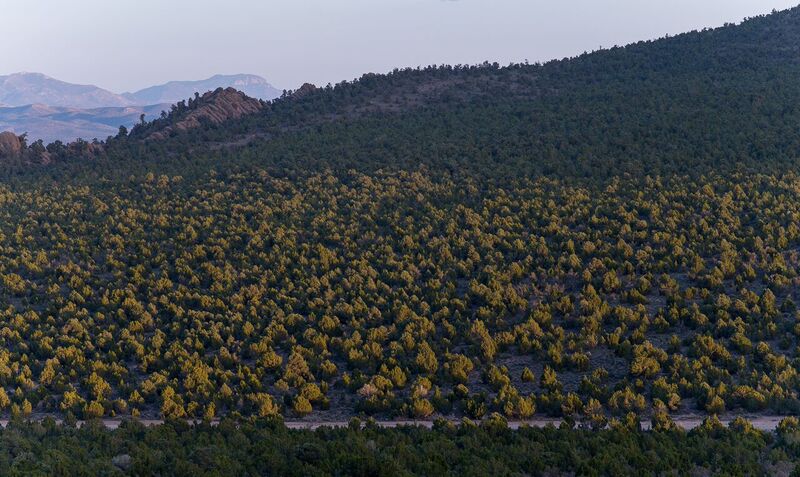
by DGR News Service | May 13, 2019 | Biodiversity & Habitat Destruction, The Solution: Resistance
via The Pinyon-Juniper Alliance
The Pinyon-Juniper Alliance was formed several years ago to protect Pinyon-Pine and Juniper forests from destruction under the BLM’s and Forest Service’s misguided “restoration” plan. Since that time, we have attended public meetings, organized petitions, talked with politicians and locals, coordinated with other groups, written articles and given presentations, and commented on public policy.
Things now are worse than ever. The latest project we’ve seen aims to remove PJ forest from more than 130,000 acres of Grand Staircase-Escalante National Monument. That’s more than 200 square miles in one project.
Everywhere we go, we see juniper trees cut. Most recently, just this past weekend in Eastern Oregon, an entire mountainside was littered with chainsawed juniper trees. Earlier today, one of our organizers spoke with an elder from the Ely-Shoshone Tribe. She told us about two conversations she had with agency employees who referred to old pinyon-pines as “useless” trees that needed to be removed. She responded by saying “I wouldn’t be here without those trees,” and told them about the importance of pine nuts to Great Basin indigenous people.
And still the mass destruction continues.
However, looming behind these atrocities is an even bigger threat. Due to global warming, drought is becoming almost continuous throughout most of the intermountain West. The possibility of a permanent dust bowl in the region appears increasingly likely as governments worldwide have done nothing to avert climate catastrophe.
Pinyon-Pine and Juniper are falling to the chainsaw. However, they have been able to survive the saws of men for two hundred years. It is unlikely they will be able to survive two hundred years of unabated global warming.
The biggest threat to Pinyon-Juniper forests isn’t chainsaws or the BLM. The biggest threat is the continuation of industrial civilization, which is leading to climate meltdown. Stopping industrial civilization would limit this threat, and would also stop the flow of fossil fuels that powers the ATVs and Masticators and Chainsaws currently decimating Pinyon-Juniper forests.
Derrick Jensen has said that often people who start out trying to protect a certain forest or meadow end up questioning the foundations of western civilization. We have undergone this process ourselves.
Given our limited time, energy, and resources, our responsibility is to focus on what we see as the larger threats. Therefore, the founders of the Pinyon-Juniper Alliance have turned to focus on revolutionary work aimed at overturning the broader “culture of empire” and the global industrial economy that powers it. We are not leaving the PJ struggle behind. If you are engaged in this fight, please reach out to us. We need to network, share information, and work together to have a chance of success. We are shifting the form of our struggle. If this struggle is won, it will result in a world that Pinyon-Juniper forest can inhabit and spread across freely once again. And if it’s lost, our work at the local level is unlikely to matter. There are few revolutionaries in the world today, and we have a responsibility to do what is necessary.











